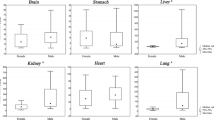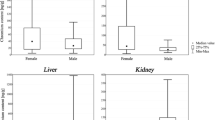Abstract
Data on the concentration of the elements in the human body are important, for example, to estimate the amounts required to maintain a good healthy state or find their connections with morbidity and mortality. In this paper, the concentration of copper (by flame atomic absorption spectrometry) in material obtained from autopsy cases of nonpoisoned people (n = 130), aged from 14 to 80 years, between 1990–2006, is presented. The following values were found (mean ± SD in micrograms of copper per gram or per milliliter): brain 3.32 ± 1.50 (n = 43), liver 3.47 ± 1.51 (n = 79), kidney 2.15 ± 0.90 (n = 76), stomach 1.10 ± 0.76 (n = 65), intestines 1.54 ± 1.19 (n = 25), lung 1.91 ± 1.30 (n = 27), spleen 1.23 ± 0.28 (n = 3), heart 3.26 ± 0.59 (n = 5), bile 3.60 ± 1.67 (n = 13), and blood 0.85 ± 0.19 (n = 73).
Similar content being viewed by others
Avoid common mistakes on your manuscript.
Introduction
Copper is widely distributed in nature and is an essential element. It is a constituent of every tissue and is stored mainly in the liver, brain, heart, kidney, and muscles. Copper can be absorbed from the stomach to the distal small intestine (with typical diet, the average copper absorption is in the range of 30–40%). The distribution of copper throughout the body is mediated by ceruloplasmin, albumin, and other copper binders [1].
Copper is involved in many biochemical processes that support life. This trace element is essential for various enzyme systems (e.g., ferroxidases, cytochrome oxidase, superoxide dismutase, tyrosinase, and dopamine β-hydroxylase) and normal cell homeostasis. A finely balanced level of copper in the body is essential for health. Deficiency, excess intake, or disturbances in its metabolism lead to disease and toxicity [1–6].
Disturbances in copper metabolism are found, for example, in Wilson’s disease [2, 5, 7]. As a result of these disturbances, copper accumulates in excess amounts in the liver, the brain, the kidneys, the cornea, and other tissues, thereby damaging them [5–7]. Copper accumulation manifests itself in severe pathologies, including neurodegeneration, liver lesions, and behavioral abnormalities [3, 7]. Other disturbance of copper metabolism occurs in Menkes disease in which copper deficiency is associated with symptoms from the CNS, vascular tissues, and bones [6, 8, 9].
Excess intake of copper, as a result of exposure (e.g., dietary) or poisoning, also leads to elevated concentrations in internal organs and body fluids and detrimental effects on the body (e.g., liver damage, gastrointestinal disturbances, blood hemolysis, kidney failure, and, in severe cases, coma and death) [5, 6].
Data of the copper concentration in the human body are important to estimate the amounts required to maintain a good healthy state or to find their connections with morbidity and mortality. There is little data on current reference values for copper in the human body (internal organs, blood, and urine). The data reviewed are rather old and originate mainly from early papers from the 1960s to the 1980s [10–14]. Some earlier data may be burdened with analytical problems resulting, among other things, from the lack of biological reference materials, which are very important in the determination of trace elements [15].
The aim of this study was to evaluate the copper concentration in human tissues and body fluids of normal subjects in Poland.
Material and Methods
Copper, in human tissues and body fluids (blood and bile), of normal subjects was determined in autopsy material subjected to forensic examination at the Institute of Forensic Research, Kraków, Poland, between 1990 and 2006. The investigated group consisted of 130 nonpoisoned people (44 women and 86 men), aged from 14 to 80 years (mean ± SD 33.6 ± 18.0 years), who are inhabitants of southern Poland.
Determination of copper was carried out by flame atomic absorption spectrometry (SP-9 800 spectrometer, Pye Unicam, Cambridge, Great Britain). Before determination, samples of investigated material were digested (20 g of internal organs were digested by nitric and sulfuric acids in closed glass apparatus; 2 ml of blood or bile were digested by nitric acid and hydrogen peroxide in a microwave system). Suprapure quality concentrated acids from Merck (Darmstadt, Germany) and deionized water (obtained from apparatus supplied by Barnstead, Dubuque, IA, USA) were used in the analysis. Characteristics of the used analytical method were relative standard deviation 4.1%, at a concentration of 4.3 μg Cu/g wet weight; detection limit (three times the standard deviation of the mean of the blank) 0.024 μg Cu/g. The accuracy of the method was checked out through the use of standard reference material, bovine liver, 1577b (Gaithersburg, MD, USA).
Results
The results obtained for the concentration of copper in tissues, bile, and blood from autopsy material are presented in Table 1. The mean concentration of copper is less or more similar to median. Reference levels of copper found in biological material by some other authors are listed in Table 2 (tissues) and Table 3 (blood and bile).
Discussion
Copper concentrations in internal organs determined in this work for the adult human population are consistent, in general, with other published findings, but there are some differences, particularly in liver levels, which are slightly lower than those found by other authors, except for the concentrations found by Bem et al. [16]. Bem et al. found quite similar copper levels in liver and kidneys of the inhabitants of northeastern Poland. In the oldest papers [11–13], about twice higher copper levels in human liver are reported.
The examined material in this study originated from nonpoisoned subjects. Data on the copper concentration in tissues of exhumed cadavers, subjects with cirrhosis, or very young children were excluded from statistical analysis. In these cases the levels of copper were high. For example, the copper level in liver from an exhumed body was 9.69 μg/g, in liver with cirrhosis 13.5 μg/g, and in liver and kidney of a 2-month-old girl 33.2 and 5.59 μg/g, respectively.
Increased levels of copper in liver in young children, and in cases of cirrhosis, are also reported by other authors. Asseth and Morseth [6] give a level of about 30 μg/g wet weight in liver of the newborn. According to Jonas et al. [17], the copper concentration in normal liver was 4.06 ± 1.6 μg/g wet weight (n = 8), whereas in cirrhotic liver without Wilson’s disease 12.69 ± 5.5 μg/g wet weight (n = 4).
The mean blood concentration of copper in our study was 0.85 ± 0.19 μg/ml, ranging from 0.57 to 1.31 μg/ml, and was somewhat lower than that given by Hamilton et al. [11], Iyengar et al. [13], Yoo et al. [18], Tietz [19], and Barany et al. [20].
When comparing data obtained by various authors, it is important to take into consideration that many factors can influence the concentration of trace elements in the body, e.g., age, state of health, living environment, and dietary habits [15, 21, 22]. Furthermore, effects because of the whole analytical procedure (sampling, determination, etc.) should also be taken into account. The differences mentioned above, between our results and the results reported by other authors, may be because of various investigated population and different analytical procedures. Moreover, some differences may originate from excluding results obtained from extremely high values (concerning exhumed cadavers, subjects with cirrhosis, or young children).
Conclusion
Copper concentrations in internal organs determined in this work for the adult polish subpopulation are consistent, in general, with other published findings. There are some differences, however, particularly in liver levels, which are slightly lower than those reported by other authors and even nearly twice lower than those given by authors of papers from the seventies and the eighties.
The mean normal blood concentration of copper was somewhat lower than that given by other authors.
The various factors (investigated population, analytical methods, and rejected extreme results) may influence the final results.
References
Wapnir RA (1998) Copper absorption and bioavailability. Am J Clin Nutr 67(Suppl):1054S–1560S
Barceloux DG (1999) Copper. J Toxicol Clin Toxicol 37:217–230
Vanderwerf SM, Cooper MJ, Stetsenko IV, Lutsenko S (2001) Copper specifically regulates intracellular phosphorylation of the Wilson’s disease protein, a human copper-transporting ATPase. J Biol Chem 276:36289–36294
Chan S, Gerson B, Subramaniam S (1998) The role of copper, molybdenum, selenium, and zinc in nutrition and health. Clin Lab Med 18:673–685
Horng CJ, Lin SR (1996) Determination of urinary zinc, chromium, and copper in steel production workers. Biol Trace Elem Res 55:307–314
Asseth J, Morseth T (1986) Copper. In: Friberg L, Nordberg GF, Vouk VB (eds) Handbook on the toxicology of metals, vol. 2. Elsevier, Amsterdam, pp 233–254
Loudianos G, Gitlin JD (2000) Wilson’s disease. Semin Liver Dis 20:252–364
Rayner MH, Suzuki KT (1994) Effect of medium copper concentration on the growth, uptake and intracellular balance of copper and zinc in Menke’s and normal control cells. BioMetals 7:253–260
Cobine PA, George GN, Winzor DJ, Harrison MD, Mogahaddas S, Dameron CT (2000) Stoichiometry of complex formation between Copper (I) and the N-terminal domain of the Menkes protein. Biochemistry 39:6857–6863
Smith H (1967) The distribution of antimony, arsenic, copper and zinc of human tissue. J Forensic Sci Soc 7:97–102
Hamilton EI, Sabbioni E, Van der Venne MT (1994) Element reference values in tissues from inhabitants of the European Community. VI. Review of elements in blood, plasma and urine and a critical evaluation of reference values for the United Kingdom population. Sci Total Environ 158:165–190
Sumino K, Hayakawa K, Shibata T, Kitamura S (1975) Heavy metals in normal Japanese tissues. Arch Environ Health 30:487–494
Iyengar GV, Kollmer WE, Bowen HJM (1978) The elemental composition of human tissues and body fluids. A compilation of values for adults. Verlag Chemie, Weinheim
Versieck J (1985) Trace elements in human body fluids and tissues. Crit Rev Clin Lab Sci 22:97–184
Iyengar GV, Woittiez J (1988) Trace elements in human clinical specimens: evaluation of literature data to identify reference values. Clin Chem 34:474–481
Bem EM, Piotrowski JK, Turzyńska E (1993) Cadmium, zinc and copper levels in the kidneys and liver of the inhabitants of north-eastern Poland. Pol J Occup Med Environ Health 6:133–141
Jonas G, Fulda G, Salameh T, Schmidt W, Kröning G, Hopt U, Nizze H (2001) Electron microscopic detection of copper in the liver of two patients with Morbus Wilson by EELS and EDX. Ultrastruct Pathol 25:111–118
Yoo Y, Lee S, Yang J, In S, Kim K, Kim S, Kwon T, Ko Y, Chung K (2000) Distribution of heavy metals in normal Korean tissues. Problems of Forensic Sciences 43:283–289
Tietz NW (ed) (1995) Clinical guide to laboratory tests. Sanders, Philadelphia, PA, USA, pp 168–169
Barany E, Bergdahl IA, Bratteby LE, Lundh T, Samuelson G, Schutz A, Skerfing S, Oskarsson A (2002) Trace element levels in whole blood and serum from Swedish adolescents. Sci Total Environ 286:129–141
Lyon TDB, Fell GS, Halls DJ, McKenna F (1989) Determination of nine inorganic elements in human autopsy tissue. J Trace Elem Electrolytes Health Dis 3:109–118
Aalbers TG, Houtman JP, Makkink B (1987) Trace-element concentrations in human autopsy tissue. Makkink Clin Chem 33:2057–2064
Haswell SJ (ed) (1991) Atomic absorption spectrometry. Theory, design and applications. Elsevier, Amsterdam, pp 368–370
Piekoszewski W, Pach J, Sadlik K, Winnik L (2000) Changes in serum copper level during detoxification of acutely poisoned drug addicts. Biol Trace Elem Res 78:1–6
Author information
Authors and Affiliations
Corresponding author
Rights and permissions
About this article
Cite this article
Lech, T., Sadlik, J.K. Copper Concentration in Body Tissues and Fluids in Normal Subjects of Southern Poland. Biol Trace Elem Res 118, 10–15 (2007). https://doi.org/10.1007/s12011-007-0014-z
Received:
Accepted:
Published:
Issue Date:
DOI: https://doi.org/10.1007/s12011-007-0014-z




